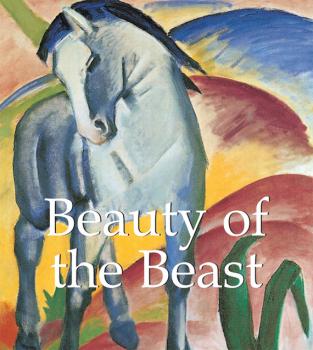Mega Square
Скачать книги из серии Mega SquareBeauty of the Beast
Throughout time, artists have maintained a close relationship with the animal world, which has proved to be an inexhaustible source of inspiration. First, they received inspiration directly from their environment. Next, animals were used in art for their status as domestic friends, symbols of an intimate and familial life, held in particularly high esteem during the Renaissance. Later, in Orientalism, animal art followed the discovery of exotic fauna which appealed to contemporary artists. The animal and its wild beauty are depicted here through works of art from Albrecht Dürer, Pieter Bruegel, Leonardo da Vinci, Katsushika Hokusai, Henri Rousseau, and Paul Klee.
Bakst
Léon Bakst (1866-1924) was a painter, illustrator, stage and costume designer. He is universally acknowledged for representing a synthesis of creative energy in the late 19th and early 20th centuries. Bakst travelled widely throughout Europe and in 1890 joined the World of Art journal circle which numbered many artists among its members, the most famous being Benois and Diaghilev. This book illustrates the wealth of Bakst's contribution to the world of theatre and dance. His best known work includes sets for Stravinsky's Firebird, and Weber's Spectre de la Rose.
Audubon's Birds
Audubon’s ambitious project to paint all the birds of North America resulted in a work that represents one of the greatest advances in ornithology. Not only did he identify new species, he also depicted birds within their natural habitat and in vivid poses. This impressive collection ranges from the Greater Flamingo and Bald Eagle to the Carolina parakeet. Audubon describes every species in concise texts, drawing attention the peculiarities of each bird.
Art Nouveau
Ever since its triumph at the Paris Universal Exposition, Art Nouveau has continued to inspire artists. The movement offered an artistic response to the industrial revolution and the creative vacuum left in its wake, exerting a huge impact on the decorative arts. Art Nouveau spans all forms of expression – including design, painting and architecture – and covers artists such as Gustav Klimt, Koloman Moser, Antoni Gaudí, Jan Toorop, and William Morris.
Apocalypse
The final book of the Bible, known both as The Book of Revelation and The Apocalypse of John, is a prophesy of the events that will occur at the end of time. During the Middle Ages, in a society which held a deep belief in God and was mainly ruled by religious authorities, this apocalyptic theme recurs in art, through various media, including tapestries, illuminations, sculpture, and painting. This book pools the most famous pieces of art inspired by this theme, such as the Apocalypse drapery from Angers Cathedral, the carved tympanum of the Autun Cathedral, and the fresco in Albi Cathedral. The theme of the Apocalypse was a means to impress minds, whilst also allowing artists to develop their imaginations; its symbolic content allowing for many different interpretations.
Angels
Even today, the splendid appearance of angels remains undiminished. Images of these heavenly and powerful messengers convey protection, innocence and calm, and have been an inspiration to religious artists throughout the history of art. This book illustrates the most impressive representations of angels, from delicate, whimsical cupids to majestic depictions of the archangel Michael, and from medieval to modern times.
Seurat
Universally celebrated for the intricacy of his pointillist canvases, Georges Seurat (1859-1891) was a painter whose stunning union of art and science produced uniquely compelling results. Seurat’s intricate paintings could take years to complete, with the magnificent results impressing the viewer with both their scientific complexity and visual impact. His Un Dimanche Après-Midi à l’Île de la Grande Jatte (Sunday Afternoon on the Island of Grand Jatte) has held its place among the most treasured and distinguished pieces of 20th-century art. Klaus H. Carl offers readers an intriguing glimpse into the detailed scientific technique behind Seurat’s pointillist masterpieces.
Paul Signac
Inspired by Monet’s work at a young age, Paul Signac (1863-1935) was a friend and disciple of Georges Seurat who combined the scientific precision of pointillism with the vivid colors and emotional expressivity of Impressionism. A close personal friend of Vincent van Gogh, who was a great admirer of his techniques, Signac traveled the world in search of inspiration for his monumental canvases. This book examines the intricacies of Signac’s celebrated technique, as well as showcasing the details of some of his most celebrated works.
The Origin of the World
Lacan, the last owner of Courbet’s The Origin of the World, loved the painting so much that he couldn’t even bring himself to look at it. Instead, he hid it behind a “safer” painting. The Chinese called it the “valley of the roses” (watch out for the thorns!), the Persians, the “honey-pot” (watch out for the bees!), and the Greeks, “the mound of Venus” (mind the steep climb!); to each era its fantasies and its theories about the feminine mystique. Then there are the testimonies of poets, painters, and even of some famous psychiatrists. The Origin of the World is a work of art only suitable for lovers of intrigue.
Van Dyck
From the time he set up his first studio at the tender age of sixteen, Sir Anthony Van Dyck (1599-1641) was a legend in the art world. Rubens, whom he studied with as a child, said that he was his most talented pupil, and he went on to spectacularly fulfill this promise with a career as a celebrated court painter in England and Spain. Historians, scholars, and art lovers alike continue to recognize the sophistication and timeless beauty of his works. In this fascinating compendium of Van Dyck’s decades-long career, Natalia Gritsai highlights the best of the artist’s many masterpieces.









